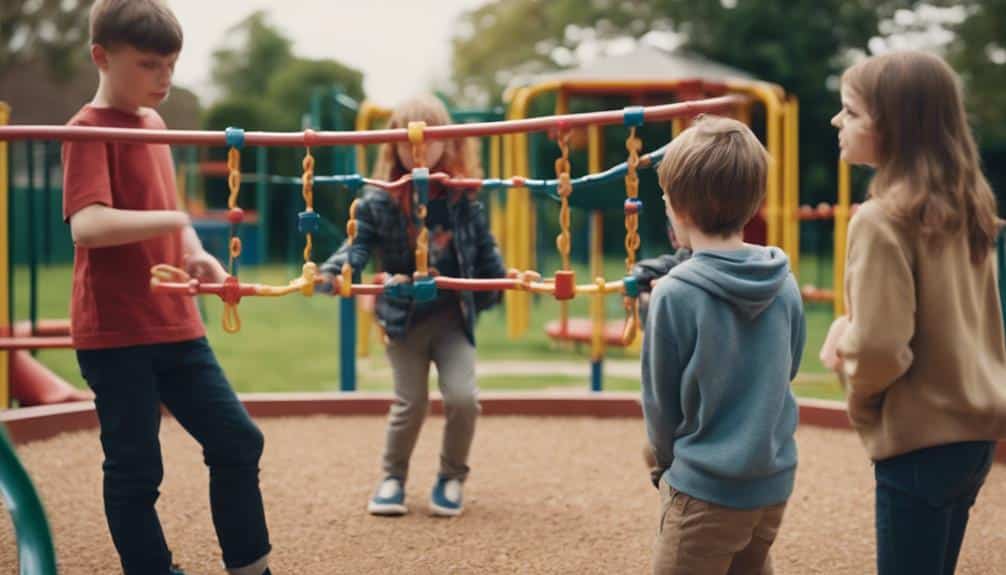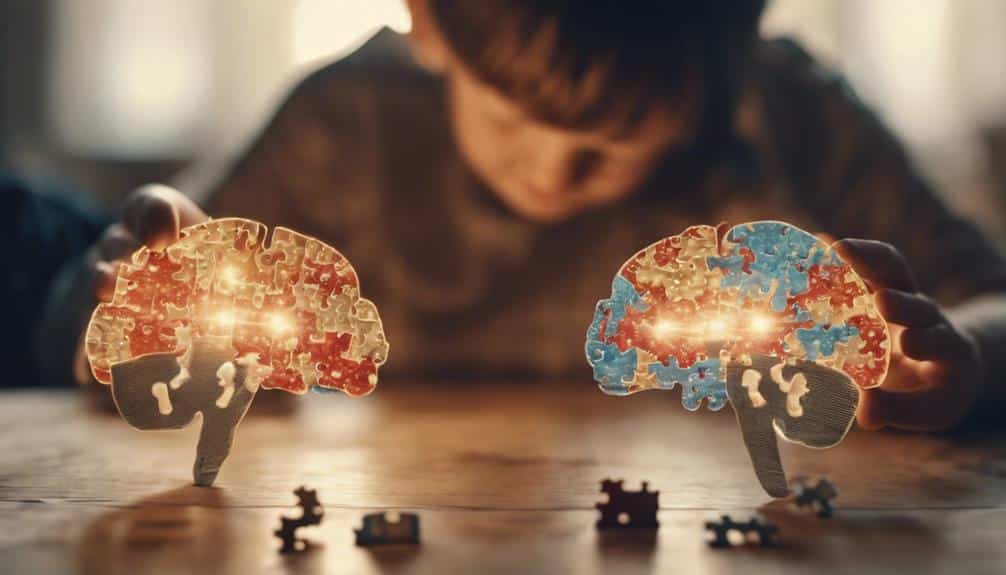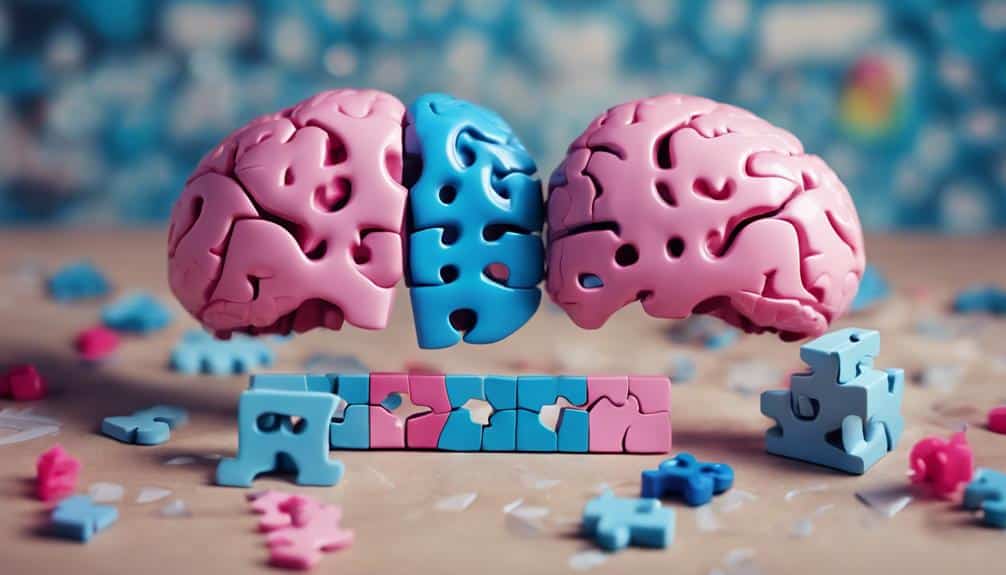Girls and boys with autism exhibit unique behavioral patterns influenced by gender-specific differences in how symptoms manifest. Boys receive diagnoses four times more frequently than girls, potentially due to diagnostic tools emphasizing symptoms typically seen in males. This disparity underscores the challenge of recognizing subtle signs in girls, such as social camouflaging, which often remain overlooked or misinterpreted.
Additionally, girls may present with distinct behaviors in areas like turn-taking, sharing, and language skills, necessitating a more nuanced approach to diagnosis. Professionals advocate for tailored support strategies to address these gender differences in identification and intervention. Further exploration of these variations promises to enhance significantly customized support for individuals with autism, empowering them to thrive in their unique developmental trajectories. Exploring the intersection of gender and autism can lead to more effective interventions and support for children with autism spectrum disorder.
Key Takeaways
- Girls with autism may engage in social camouflaging and masking symptoms, unlike boys.
- Boys with autism exhibit more pronounced repetitive and restricted behaviors.
- Autistic girls often show different turn-taking and sharing behaviors compared to boys.
- Language and communication skills vary, with girls displaying subtler differences than boys.
- Social mimicry and motor skills differences are observed between girls and boys with autism.
Autism Prevalence by Gender
In examining the prevalence of autism by gender, it is evident that boys are diagnosed with the condition four times more frequently than girls. This disparity raises essential questions about diagnostic practices and the manifestation of symptoms across genders. This statistic not only highlights a significant gender difference in autism but also suggests a deeper issue within the framework used to identify and diagnose the condition.
The conventional diagnostic tools, primarily developed based on male presentations of autism, may inadvertently overlook or misinterpret the less apparent symptoms often exhibited by girls. This oversight underscores the critical need for a nuanced understanding of gender differences in autism, prompting healthcare professionals and researchers to reconsider and refine their approaches to diagnosis.
Diagnosing Autism in Girls
The process of diagnosing autism in girls presents distinctive challenges, necessitating a nuanced understanding of subtle signs that may vary significantly from those typically observed in boys. Gender bias in diagnostic practices, rooted in tools primarily designed with male presentations in mind, often leads to overlooked or misinterpreted symptoms in girls, further complicating their path to an accurate diagnosis. Addressing these challenges requires not only a shift in professional awareness but also the development of tailored support strategies that acknowledge and cater to the specific needs of girls with autism.
Recognizing Subtle Signs
Understanding the nuanced and often subtle signs of autism in girls is a crucial step toward ensuring they receive the accurate diagnosis and support they need. Girls with autism may not display the classic symptoms observed in boys, leading to challenges in diagnosis. They often engage in social camouflaging, a strategy where they mask their symptoms by imitating the social behavior of their peers.
This ability to blend in can lead to underdiagnosis, as their struggles remain hidden behind seemingly adaptive social skills. Professionals need to be keenly aware of these distinct presentations of autism in girls. This includes recognizing less overt signs and understanding the role of social camouflaging. Tailoring diagnostic approaches to account for these characteristics is essential for supporting girls with autism effectively.
Gender Bias in Diagnosis
Gender bias in the diagnosis of autism dramatically contributes to the disparities observed between girls and boys, often leading to underdiagnosis or misdiagnosis in girls. The prevalence of autism diagnosis being four times more common in boys than in girls hints at a significant underdiagnosis in girls, who may exhibit less noticeable symptoms and engage in behavior camouflaging. This discrepancy is exacerbated by diagnostic tools primarily based on male-centric autism presentations, which do not adequately capture the manifestation of autism in girls.
Additionally, a lack of professional awareness regarding the presentation of autism in girls can lead to incorrect diagnoses, such as anxiety or depression, further obscuring the accurate picture. Consequently, many girls with autism may internalize their struggles, delaying critical intervention and support.
Support Strategies for Girls
Addressing the challenges in diagnosing autism in girls requires a multifaceted approach that emphasizes education, adaptation of diagnostic tools, and a deeper understanding of camouflaging behaviors. The delayed diagnosis in girls, often due to gender differences and diagnostic challenges, calls for enhanced awareness among healthcare providers. Emphasizing the importance of recognizing camouflaging behaviors can reveal the hidden struggles of girls with autism, allowing for timely and appropriate interventions.
Adjusting diagnostic criteria and tools to reflect the distinct presentation of autism in girls is essential. Additionally, support strategies need to be tailored to address the specific needs of girls, including social support and therapeutic interventions that consider the internalization of symptoms. Such an all-encompassing strategy can bridge the gap in support and interventions for girls with autism.
Behavioral Differences Identified
Research indicates that girls with autism often present less severe repetitive and restricted behaviors than their male counterparts, highlighting a critical gender disparity in the manifestation of the disorder. This differentiation underscores the importance of gender-sensitive approaches in the diagnosis and understanding of autism. Despite boys and girls with autism showing similar scores in social behavior and communication, the gender differences in core phenotypic features, especially in the expression of autistic traits, are significant.
These variations have been consistently observed and confirmed in replication studies, suggesting that girls tend to display more typical scores on standard measurements of repetitive behavior.
Understanding these gender differences is paramount in enhancing the recognition and treatment of autism. It suggests that current diagnostic criteria, which are often based on studies mainly involving males, may not fully capture the spectrum of autistic traits, especially in females. This gap in diagnosis underscores the need for a more inclusive and nuanced understanding of autism’s core features, taking into account the gender variations in its expression. Such insights promise to pave the way for more tailored and effective interventions, ensuring that all individuals on the autism spectrum receive the support and understanding they deserve.
Social Skills and Interaction

Exploring the nuances of social skills and interaction in children with autism reveals significant gender-based differences, especially in aspects such as eye contact variations and group play dynamics. Girls with autism may utilize essential strategies to maintain eye contact, aiding in their social camouflage, whereas boys might display more noticeable difficulties in this area, impacting their social interactions. Understanding these differences is vital for tailoring interventions that effectively support the development of social skills in boys and girls with autism, recognizing the individual challenges and strengths each gender presents.
Eye Contact Variations
Understanding the variations in eye contact among children with autism is essential, as these differences can significantly impact their social skills and communication abilities. The nuanced understanding of these variations can guide more personalized interventions, enhancing the efficacy of support provided to individuals with autism.
- Boys with autism tend to engage in less frequent eye contact than their typically developing counterparts, indicating a distinctive challenge in social interaction.
- Girls with autism may exhibit more eye contact compared to boys with autism, suggesting gender-specific nuances in autism.
- Common Challenge: Eye contact difficulties are broadly recognized as a challenge in social interactions for individuals with autism.
- Impact on Communication: Variations in eye contact patterns significantly influence the development of social skills and communication abilities in autism.
Empathetically analyzing these factors can help tailor interventions that respect individual differences and promote better communication and social engagement.
Group Play Dynamics
In the domain of group play dynamics, gender differences in autism present distinct challenges and behaviors in social skills and interaction. Girls with autism often engage in parallel play, preferring activities adjacent to peers without direct interaction, which could limit opportunities for developing intricate social exchanges. Conversely, boys with autism might find turn-taking and sharing during group activities more challenging, potentially leading to conflicts or isolation.
Girls may exhibit more cooperative play behaviors in structured environments, suggesting a nuanced understanding of social cues within familiar frameworks. Boys, however, often lean towards competitive or solitary play in group settings, highlighting a preference for activities that require less direct social negotiation. These differences underscore the importance of tailored approaches in fostering positive peer interactions and friendships among autistic children, acknowledging the distinct social skills and challenges each child brings to group play dynamics.
Language and Communication
When exploring the domain of language and communication within the context of autism, it becomes apparent that autistic girls often demonstrate advanced vocabulary skills compared to their male counterparts, underscoring the need for gender-specific approaches in comprehending and supporting their communication needs. This observation invites a more profound analysis of how language and communication manifest differently across genders in autism, advocating for tailored interventions that address these nuanced differences.
- Language Skills: Autistic girls frequently exhibit a more sophisticated use of language, necessitating approaches that leverage this strength in therapeutic and educational settings.
- Communication Patterns: How girls with autism imitate their parents or peers can reveal exceptional communication strategies, diverging from the patterns often seen in boys, which may influence social learning and interaction.
- Verbal Communication: Although there are no considerable gender differences in verbal communication and friendship behaviors, the subtleties in how girls with autism use and interpret verbal cues can be characteristic.
- Social Behaviors: Social communication symptoms often present differently in females, highlighting the importance of gender-specific understanding to better support their social engagement and relationships.
Recognizing and adapting to these gender-specific nuances in language and communication can notably enhance the support provided to autistic girls, fostering an environment where they can thrive.
Autism and Epilepsy Connection

Exploring beyond the domain of language and communication differences in autism, it is essential to examine the significant correlation between autism spectrum disorder (ASD) and epilepsy. This pairing introduces complex challenges in both diagnosis and treatment. The research underscores a higher prevalence of epilepsy among individuals with ASD, highlighting a critical intersection that requires a nuanced understanding and approach. The co-occurrence of these conditions complicates the clinical picture and demands a tailored strategy to manage and support the affected individuals effectively.
Delving into this relationship reveals a bidirectional dynamic where each condition may exacerbately influence the other, complicating the clinical approach. Seizures, a common manifestation of epilepsy, can profoundly impact the cognitive and behavioral functioning of individuals with ASD, further emphasizing the need for a holistic and empathetic approach to care. Understanding this co-occurrence is paramount in developing thorough care plans that address neurological and behavioral conditions.
In essence, the intersection between epilepsy and ASD presents exceptional challenges that necessitate a collaborative, informed, and compassionate approach to ensure the well-being and development of affected individuals.
High-Functioning Autism in Boys
The prevalence of high-functioning autism diagnoses is notably higher in boys than in girls, with a ratio of four to one, underscoring the importance of understanding gender-specific manifestations and challenges in autism spectrum disorder. This discrepancy not only highlights a substantial gender difference in the autism community but also emphasizes the need for tailored approaches to intervention and support for boys diagnosed with autism.
Critical considerations for addressing high-functioning autism in boys include:
- Prevalence and Diagnosis: Boys are diagnosed with high-functioning autism at a considerably higher rate than girls, necessitating a keen awareness and understanding of the male presentation of autism.
- Repetitive Behaviors: Boys with autism often exhibit more pronounced repetitive and restricted behaviors, which can impact social integration and learning.
- Behavioral Skills: Understanding the gender differences in autism can guide the development of strategies to identify and remediate critical behavioral skills, enhancing the quality of life and opportunities for boys with autism.
- Tailored Support: Recognizing and addressing the distinct challenges faced by boys with autism through tailored support can significantly improve outcomes, fostering greater independence and social engagement.
Brain Structure Variations

Significant gender-specific variations in brain structure among children with autism highlight the need for nuanced understanding and approaches in both diagnosis and treatment. Research has uncovered that gender differences in brain structure, already noted among typically developing boys and girls, extend into the context of autism, affecting key brain regions linked to motor function. These variations are not merely individual; they have tangible implications for the behaviors observed in children with autism, especially in how repetitive behaviors, which often have a motor component, manifest differently between genders.
The discovery that gray matter patterns in motor regions can effectively distinguish girls from boys with autism offers a compelling insight into the biological underpinnings of these behavioral differences. Such findings underscore the importance of considering gender differences when analyzing brain structure in autism. Practitioners can offer more customized and effective interventions by tailoring diagnosis and treatment approaches to account for these distinctions.
This empathetic, detailed understanding of the intricate relationship between brain structure, gender differences, motor function, and repetitive behaviors enriches our capacity to serve the diverse needs of children with autism, advocating for a more informed and inclusive approach to their care.
Impact of Intelligence Quotient
Understanding the role of the Intelligence Quotient (IQ) in autism reveals that girls often display higher cognitive abilities than their male counterparts, presenting a critical dimension in tailoring interventions and support. This discrepancy between genders underscores the necessity of recognizing and addressing the specific needs of individuals with autism spectrum disorders (ASD), especially when it comes to developing educational and therapeutic strategies.
- Gender Differences in Intellectual Disabilities: Boys with autism are more frequently diagnosed with intellectual disabilities, emphasizing the need for gender-specific approaches in assessment and support.
- Cognitive Abilities Across the Spectrum: Despite the gender disparities, individuals of both genders can exhibit remarkable skills in certain intellectual domains, highlighting the importance of customized educational programs.
- Variability in Intellectual Abilities: The range of intellectual abilities among individuals with autism, regardless of gender, demands a flexible, tailored approach to intervention strategies.
- Significance of Early Intervention: Early and appropriate support can significantly influence the intellectual development of individuals with autism, making it imperative to understand and act upon gender differences in cognitive abilities.
Social Mimicry in Females

Recognizing the cognitive abilities of persons with autism necessitates a nuanced exploration of how autistic girls often utilize social imitation to integrate with their peers. This phenomenon, known as social mimicry, is a common strategy among autistic girls aiming to navigate the complexities of social interactions effectively. By imitating the social behaviors and cues of their non-autistic peers, these girls attempt to blend in, a tactic that, while potentially essential in fostering a sense of belonging, can inadvertently mask their symptoms.
The practice of social mimicry by autistic girls raises significant challenges for clinicians and educators in accurately identifying their condition. Since these girls can adeptly mimic social cues, their autism may present less overtly than in boys, leading to a delay in diagnosis. This delay is not merely crucial; it impacts the timely intervention and support critical for their development and well-being.
Therefore, understanding the role of social mimicry in autistic girls is essential. It calls for a sensitive, informed approach to diagnosis and support that recognizes the distinct ways in which autism can manifest across genders. Acknowledging and addressing these distinctions ensures that all individuals on the autism spectrum receive the understanding and assistance they deserve.
Motor and Communication Abilities
Investigating the domain of motor and communication abilities reveals subtle differences between boys and girls diagnosed with autism. Importantly, variations in motor skills and communication challenges highlight the significant impact of gender on the autism experience. This analysis aims to promote a deeper understanding of these disparities, paving the way for tailored interventions that address each child’s needs.
Motor Skills Variation
Research indicates that girls with autism may demonstrate superior motor skills compared to boys with autism, underscoring the necessity of considering gender differences when evaluating and developing interventions for motor and communication abilities. This variance in motor skills between genders can profoundly influence how individuals with autism navigate both physical and social environments, highlighting the importance of tailored support.
- Gender-Specific Interventions: Tailoring therapeutic activities that cater to the distinct motor skills profiles of boys and girls with autism.
- Holistic Evaluation: Incorporating gender considerations in assessments to understand the full spectrum of developmental challenges.
- Enhanced Participation: Encouraging engagement in physical activities that align with each child’s motor abilities, promoting inclusivity.
- Informed Support: Educating caregivers and professionals about the impact of gender differences on motor skills and communication abilities in autism.
Communication Challenges
How do gender differences influence communication challenges in children with autism, especially in social interactions and motor abilities related to communication? Boys with autism often face more pronounced difficulties in social communication, which can be directly linked to the broader autism traits they exhibit. Conversely, girls tend to mimic social behaviors to blend in, which might mask their communication challenges but does not negate their struggle.
These gender differences in communication abilities notably impact how symptoms manifest, influencing diagnosis and intervention strategies. Additionally, motor function disparities in communication reveal that girls and boys with autism navigate these challenges differently. Girls may form smaller social circles yet create deeper connections, showcasing a distinct adaptation to their communication challenges. This nuanced understanding of gender differences underscores the importance of tailored approaches in addressing the communication skills and social communication needs of children with autism.
Gender Differences Impact
Gender differences in autism manifest prominently in motor and communication abilities, necessitating nuanced approaches to diagnosis and intervention. These disparities underscore the importance of personalized care strategies that consider the particular challenges each gender faces.
- Brain Structure Variance: Girls with autism display differences in brain structure that impact motor skills, especially in areas governing motor function.
- Repetitive Behaviors: The significant motor component of repetitive behaviors in autism presents differently in boys and girls, affecting diagnosis and intervention strategies.
- Gray Matter Patterns: Variations in gray matter in motor regions can distinguish between genders in autism, highlighting the need for gender-specific diagnostic tools.
- Tailored Diagnosis and Treatments: Acknowledging gender-based differences in brain structure and motor skills is essential for developing effective, personalized interventions and support for individuals with autism.
Repetitive Behaviors Analysis
Analyzing the differences in repetitive behaviors between girls and boys with autism reveals significant gender-based variations, underscoring the need for tailored intervention strategies. Girls with autism tend to exhibit less severe forms of repetitive and restricted behaviors compared to their male counterparts. This differentiation is critical, as it highlights the nuanced nature of autism spectrum disorder (ASD) and the importance of recognizing gender differences in symptomatology.
Research consistently shows that on measures of repetitive and restricted behaviors, girls with autism score lower than boys. These findings are not isolated but have been replicated across various studies, confirming the milder nature of repetitive behaviors in girls with autism.
Understanding these gender differences is paramount in developing and implementing interventions that are specifically designed to meet the distinct needs of girls and boys with autism. It also challenges the one-size-fits-all approach often applied in therapeutic settings, advocating for a more personalized and gender-sensitive support model. By acknowledging and addressing the specific patterns of repetitive behaviors among girls and boys with autism, professionals and caregivers can better serve this diverse population, ensuring more effective and empathetic support.
Gender Similarities and Divergences

While girls with autism exhibit less severe repetitive and restricted behaviors than boys, both genders display comparable levels of social behavior and communication, pointing toward a complex landscape of gender similarities and divergences in autism spectrum disorders. This nuanced understanding suggests that while autistic traits manifest in both genders, the expression and severity of these traits can markedly differ, illuminating the importance of gender-sensitive approaches in diagnosis and intervention.
To further elaborate on these gender-related nuances in autism:
- Females tend to exhibit less pronounced repetitive behaviors, suggesting a gender-specific manifestation of autism.
- Males and females show similar social behavior and communication capabilities, highlighting a base level of shared autistic traits across genders.
- Standardized measurements often reveal more ‘normal’ scores for females in repetitive behaviors, pointing to potential diagnostic blind spots.
- Replication studies underscore gender differences in core phenotypic features, emphasizing the critical need for gender-inclusive research and practices in the field of autism.
Understanding these gender similarities and divergences enhances our capacity to serve individuals with autism effectively, advocating for a more inclusive and empathetic approach to care and support.
Importance of Accurate Diagnosis
The precise diagnosis of autism in girls presents distinctive challenges due to their often non-traditional symptom presentation and tendency to mask behaviors. This disparity in diagnosis can significantly impact the timeliness and effectiveness of interventions and supports tailored to their needs. It underscores the necessity for diagnostic tools and criteria that are finely tuned to the diverse manifestations of autism, particularly in girls, to guarantee they receive the crucial support required for their development and well-being.
Diagnostic Challenges
Identifying autism in girls presents significant diagnostic challenges, primarily due to the gender-specific presentation of symptoms that are often overlooked or misinterpreted by healthcare professionals. The nuances of sex and gender in autistic females elicit a distinct set of difficulties, emphasizing the urgency for refined diagnostic criteria to avert missed diagnoses.
- Diagnostic Tools Bias: Mainly based on male presentations, current diagnostic tools may not capture the subtleties of autism in girls.
- Camouflaging Effect: Girls often mask their symptoms more effectively, leading to underdiagnosis.
- Professional Awareness Gap: A lack of understanding regarding gender differences in autism presentation can delay or miss diagnosis.
- Misdiagnosis Trend: Girls are frequently misdiagnosed with conditions like anxiety or depression, complicating the identification of autism.
Accurate diagnosis is crucial for ensuring that autistic females receive the timely interventions and support necessary for their well-being.
Impact on Treatment
Acknowledging the crucial role of precise diagnosis in autism, personalized treatment plans that consider nuanced gender-specific behavioral differences are essential for optimizing therapeutic outcomes for both girls and boys. An accurate diagnosis is the foundation for developing interventions that are attuned to the specific needs of each child, considering the different gender-specific behaviors observed in boys and girls with autism. By doing so, professionals can design targeted therapies that greatly enhance developmental progress.
This approach respects each child’s individuality and maximizes the potential for positive outcomes. Emphasizing the importance of understanding these behavioral variations ensures that every child receives the support necessary to thrive, making accurate diagnosis and tailored treatment indispensable tools in the journey toward developmental progress.
Frequently Asked Questions
How Do Autistic Girls Differ From Autistic Boys?
Autistic girls often show less noticeable repetitive behaviors and may utilize social masking, leading to underdiagnosis. They demonstrate similar social and communication skills as boys but might have unique interests, requiring personalized support approaches.
How Does ASD Impact Boys Differently Than Girls?
Autism Spectrum Disorder (ASD) affects boys and girls uniquely, with boys often showing more externalizing behaviors and girls potentially participating in social camouflaging, resulting in nuanced differences in diagnosis and intervention strategies for each gender.
How Does a Child With Autism Behave?
Children with autism may exhibit many behaviors, including repetitive actions, sensitivity to sensory stimuli, and social communication difficulties. Tailored interventions can nurture their abilities, providing enhanced interaction and understanding.
What Are the Behavioral Differences of Gender and Autism?
Behavioral differences in autism encompass a range of symptoms, especially in social communication and repetitive behaviors. Understanding these variations is essential for developing compassionate, personalized support strategies that address each person’s needs and challenges.
Conclusion
Research exploring the intersection of gender and autism has revealed significant differences in how symptoms manifest among individuals. For instance, males are diagnosed with Autism Spectrum Disorder (ASD) at a much higher ratio in comparison to females. Previous studies conducted in the United States have indicated this disparity, highlighting the need for further investigation into gender-specific aspects of autism diagnosis and intervention.
In a recent study published in the Journal of Autism and Developmental Disorders, researchers conducted a systematic review of the neurobiology of autism, specifically focusing on gender-diverse individuals. The analysis included participants ranging from children to adults with autism spectrum diagnoses, with a particular emphasis on exploring differences in brain regions such as the prefrontal cortex and temporal sulcus. Findings from this study shed light on the complexity of autism diagnosis interaction effects and underscore the importance of considering gender diversity in autism research.
Understanding the nuanced relationship between gender and autism is crucial for providing practical support and interventions for autistic individuals. By acknowledging and addressing these gender-specific differences, researchers and practitioners can better tailor strategies to meet the diverse needs of autistic males and females. Further research in this area, particularly regarding sex-specific genes and cortical regions, holds promise for advancing our understanding and improving outcomes for individuals across the autism spectrum.
But by reporting those results as applicable to anyone with autism, scientists do a disservice both to girls, who might have different needs than boys do, and to boys, whose results might be diluted by the inclusion of girls. “To specifically look at whether a treatment differs as it applies to boys versus girls, it’s best to have an equal sample size of the two sexes,” says Meng-Chuan Lai, who studies gender and autism at the University of Toronto. “That’s something that hasn’t been done.”
One challenge with recruiting women and girls into autism studies is that they tend to accumulate misdiagnoses or additional diagnoses, including bipolar disorder, depression, and anxiety — often delaying their autism diagnosis.


Recent Comments